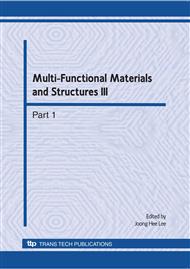p.955
p.959
p.963
p.967
p.971
p.975
p.979
p.983
p.987
Evaluation of Fracture Toughness of Ceramic-Metal Functionally Graded Materials
Abstract:
The main objective of this study is to examine the two dimensional surface crack problems in a system with an interface between two elastic-plastic solids of different yield strength subjected to mode I mechanical loading. The surface cracks growth is considered to occure along the interface direction of bimaterials which is perfectly bonded to each others. A two dimensional finite elementmethod is used to solve the structural problem. Solid 183-node elements are utilized to simulate the strain singularity around the crack front. The crack surface is subjected to a compressive load by three point bending. The stress intesity factors are computed by using the displacement correlation technique. The primary goal is to develop a model crack tip stresses and strains in a manner that is useful for crack growth initiation and propagation in a FGM.
Info:
Periodical:
Pages:
971-974
Citation:
Online since:
August 2010
Authors:
Price:
Сopyright:
© 2010 Trans Tech Publications Ltd. All Rights Reserved
Share:
Citation:


